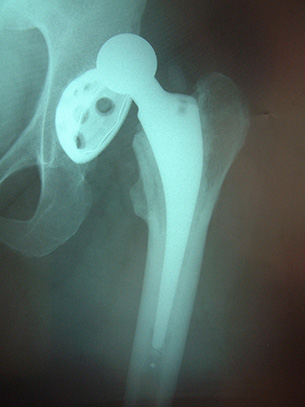Audio
THR History and Development

A dislocated total hip replacement – ouch! In fact, although this can appear to be a major problem at the time, the majority of patients come through one of these unscathed and without any significant troubles for the future.
Although hip replacement is an astonishingly successful operation, it would be wrong to pretend that surgery always proceeds as planned. Complications do occur, and it is essential that all patients contemplating surgery are aware of their existence. However, please do not allow your imagination to blow matters out of proportion. In reality, complications are infrequent and most are reversible. Age is an important issue. The older the patient, the more likely it is that complications will occur. For those over the age of 80 years, for example, 20% are likely to experience at least one complication after hip replacement.
Complications are of three sorts:
- Operative
- Post-operative
- Long-term (six months or more after surgery)
Operative complications
- Nerve damage (risk: 0.5-3.5%)
- Vascular damage (risk: 0.1% for primary replacements; less than 1% for revision replacements)
- Cortical perforation (risk: up to 4.5%)
- Fracture (risk: less than 1% for primary replacements; 3% for revision replacements)
- Leg length inequality (risk: 6% for primary replacements; 7.5% for revision replacements)
- Entrapped drain
- Cement extrusion
- Anaesthetic complications
Post-operative complications
- Nerve damage
- Dislocation (risk: 0.5-3%)
- Infection (risk: 7% for superficial infection; 0.5% for deep infection)
- Trochanteric problems (risk: 9.5% for trochanteric non-union; 17% for trochanteric bursitis)
- Bowel complications (risk: 1%)
- Urinary complications (risk: up to 35%)
- Cardiovascular complications, including deep vein thrombosis (risk: up to 56%)
- Haematoma formation (risk: 3%)
- Wound dehiscence
- Respiratory complications (risk: 1%)
- Prosthetic displacement
- Knee pain
- Swollen ankles
- Skin complications (risk: less than 1%)
- Metabolic complications (risk: less than 1%)
- Death (risk: 1%)
Long-term complications
- Aseptic loosening
- Bone stock loss
- Component fracture
- Late dislocation (risk: 2%)
- Late infection (risk: less than 1%)
- Bone fracture (risk: less than 1%)
- Ectopic ossification (7% for primary replacements; 15% for revision replacements)
The list above will appear long to anyone who wishes to undergo hip replacement surgery. Unfortunately it represents the reality of the situation and, perhaps, concentrates the mind as to whether or not surgery is definitely needed. Please also understand that the list is not comprehensive. This is why a surgeon will frequently struggle to dissuade a patient from having a hip replacement, particularly in the young. Some of the terms used may be unfamiliar to you. If so, please ask your surgeon or obtain a copy of Richard Villar’s Understanding Hip & Knee Arthritis Surgery for further details.
